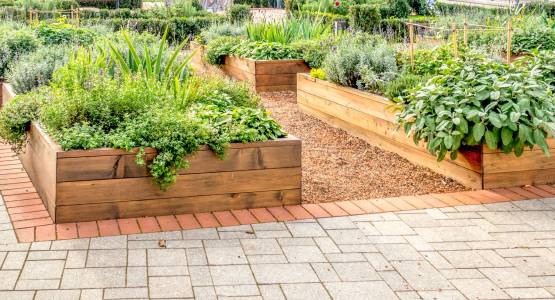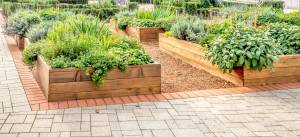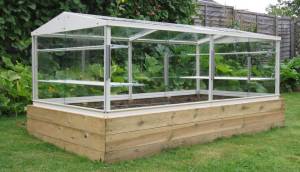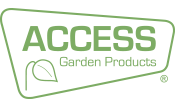What Are the Best Vegetables to Grow in Raised Beds?


Raised beds are a fantastic option for gardeners, offering a controlled environment where you can cultivate a wide variety of vegetables with greater success. Raised beds allow you to control soil quality, drainage, and even temperature, which is particularly useful in our often-unpredictable climate. Raised beds from Access also have the advantage that a cold frame can be added on top, providing shelter for the vegetables and allowing even earlier planting and cropping.
In this guide, we’ll explore the best vegetables to grow in raised beds, how to care for your plants, tips for harvesting, and the added benefits of using a cold frame. We’ll also share some recipes to help you make the most of your home-grown vegetables, showcasing the superior flavour and reduced food miles that come with growing your own produce.
Why Grow Vegetables in Raised Beds?
Raised beds offer a range of advantages for gardeners, particularly in regions like the UK where the weather can be a challenge. Here are some benefits of raised bed gardening:
- Improved Soil Quality: You can customise the soil mix in raised beds, ensuring it’s rich, well-draining, and fertile for vegetables.
- Better Drainage: Raised beds improve drainage, preventing waterlogging and root rot, which can be a problem in areas with heavy rainfall.
- Warmer Soil: The soil in raised beds warms up more quickly in the spring, extending your growing season.
- Easier Access: Raised beds reduce the need for bending and kneeling, making gardening more accessible and enjoyable.
- Pest Control: You can more easily manage pests and weeds in a raised bed environment.
Best Vegetables to Grow in Raised Beds
The controlled conditions of raised beds make them ideal for a wide variety of vegetables. Here are some of the best choices for gardeners:
Carrots
- Varieties to Try: ‘Nantes’, ‘Chantenay‘, ‘Autumn King’
- Why Raised Beds? Carrots thrive in the loose, well-draining soil of raised beds, which helps them develop long, straight roots.
- Care Tips: Sow seeds directly in the soil, thinning out seedlings to 2-3 cm apart. Carrots need consistent watering but should not be waterlogged. Add mulch to retain moisture and prevent weeds.
- Harvesting: Carrots can be harvested when they’re finger-sized or larger, depending on your preference. Early varieties can be ready in as little as 10 weeks.
- Recipe: Roast your home-grown carrots with olive oil, honey, and thyme for a sweet and savoury side dish.
Lettuce
- Varieties to Try: ‘Little Gem’, ‘Lollo Rosso’, ‘Butterhead’
- Why Raised Beds? Lettuce benefits from the well-draining and nutrient-rich soil of raised beds, and the elevation helps keep slugs and snails at bay.
- Care Tips: Sow seeds thinly, either directly in the bed or under a cold frame for an earlier crop. Water regularly and protect young plants from slugs and other pests with organic barriers.
- Harvesting: You can harvest lettuce leaves as a cut-and-come-again crop or wait for full heads to form. Depending on the variety, lettuce can be ready in 4-6 weeks.
- Recipe: Use fresh lettuce in a crisp summer salad with radishes, cucumbers, and a light vinaigrette dressing.
Beetroot
- Varieties to Try: ‘Boltardy’, ‘Chioggia’, ‘Golden’
- Why Raised Beds? Beetroot prefers the loose, well-drained soil of raised beds, which allows for easy root development.
- Care Tips: Sow beetroot seeds directly in the bed, thinning them out as they grow. Water consistently, particularly in dry weather, to avoid woody roots.
- Harvesting: Beetroot can be harvested when they are about the size of a golf ball or left to grow larger. Younger beets tend to be more tender and flavourful.
- Recipe: Roast beetroot with a drizzle of olive oil and sea salt for a delicious side, or blend it into a vibrant beetroot and goat cheese salad.
Spinach
- Varieties to Try: ‘Medania’, ‘Perpetual’, ‘Lazio’
- Why Raised Beds? Raised beds help with drainage and make it easier to manage pests like slugs, which are attracted to spinach.
- Care Tips: Spinach grows quickly, so sow seeds in succession for a continuous harvest. Keep the soil moist and harvest regularly to encourage new growth.
- Harvesting: Spinach leaves can be picked when young for tender baby leaves or left to grow larger. Harvesting frequently encourages more growth.
- Recipe: Wilt spinach into a stir-fry or mix it into a quiche with fresh eggs and cheese for a nutritious meal.
Onions
- Varieties to Try: ‘Red Baron’, ‘Sturon’, ‘Centurion’
- Why Raised Beds? Onions do well in the well-draining soil of raised beds, where they are less prone to rot. Cold Frames over the top of the onions also keeps them drier and the harvested onions can be dried on the shelves of the cold frame.
- Care Tips: Onions can be grown from sets (small bulbs) or seeds. Space them 10-15 cm apart and water them regularly, especially during dry spells. Avoid overwatering to prevent rot.

- Harvesting: Onions are ready to harvest when the tops turn yellow and fall over. Let them dry in the sun before storing.
- Recipe: Caramelise home-grown onions and serve them with sausages or use them in a French onion soup.
Courgettes (Zucchini)
- Varieties to Try: ‘Defender’, ‘Black Beauty’, ‘Soleil’
- Why Raised Beds? Courgettes are heavy feeders, and raised beds allow you to provide the rich soil they need for vigorous growth. Again, a Cold Frame really helps with fruit growth as the glass keeps the crop warmer and drier – more like the Mediterranean.
- Care Tips: Courgettes need plenty of space, so allow 90 cm between plants. Water generously and apply compost or well-rotted manure as a top dressing.
- Harvesting: Courgettes are best harvested when they’re around 15-20 cm long. Frequent harvesting encourages more fruit.
- Recipe: Slice and grill courgettes with a sprinkle of sea salt and olive oil, or grate them into fritters for a light, summery dish.
Using a Cold Frame on Raised Beds
A cold frame can be a valuable addition to your raised beds, particularly in the UK where the growing season is shorter. Cold frames provide a protected environment that traps heat from the sun, extending your growing season in both spring and autumn. Here’s how using a cold frame can benefit your vegetable gardening:
- Early Start: A cold frame allows you to start sowing seeds earlier in the year by providing warmth and shelter from late frosts. The soil of the raised bed is warmed more quickly in the early season and also provides a thermal mass, stabilising overnight temperatures and reducing the effect of overnight frosts.
- Hardening Off: Before transplanting seedlings from indoors to outdoor raised beds, you can harden them off in the cold frame, helping them adjust to outdoor conditions gradually.
- Extended Harvest: Harvesting will be earlier for plants in the cold frame. In addition, as the growing season comes to an end, you can use a cold frame to keep crops like lettuce, spinach, and radishes going well into the autumn.
What to Grow in a Cold Frame

Cold-hardy vegetables such as lettuce, spinach, radishes, and early carrots are perfect for cold frames. You can also use them for hardening off summer vegetables like tomatoes or starting your autumn crops early.
Common Pests and How to Manage Them
Even in raised beds, pests can pose a challenge. Here’s how to manage some common culprits:
- Slugs and Snails
- Problem: Slugs and snails are particularly fond of lettuce, spinach, and other leafy greens.
- Solution: Use organic slug pellets, copper tape around the raised bed edges, or hand-pick them in the evening. Crushed sea shells and egg shells can also be used to form a barrier.
- Carrot Fly
- Problem: Carrot fly larvae can damage the roots of carrots and other root vegetables.
- Solution: Plant carrots later in the season when flies are less active, or cover the bed with fine mesh.
- Aphids
- Problem: Aphids suck sap from young shoots, weakening plants.
- Solution: Use insecticidal soap or introduce natural predators like ladybirds.
- Cabbage White Butterfly
- Problem: Their larvae feed on brassicas, causing significant damage to leaves.
- Solution: Use netting to cover brassica plants and inspect regularly for eggs.
Harvesting Times
Raised beds can help you harvest a wide range of vegetables throughout the growing season. Here’s a general guide to harvesting times:
- Carrots: 10-12 weeks after sowing
- Lettuce: 4-6 weeks after sowing
- Beetroot: 8-12 weeks after sowing
- Spinach: 4-6 weeks after sowing
- Onions: 20-24 weeks after sowing
- Courgettes: 8-12 weeks after sowing
The Joy of Home-Grown Vegetables: Recipes and the Benefits of No Food Miles
One of the greatest rewards of growing your own vegetables is the superior flavour that comes from freshly harvested produce. When vegetables are picked straight from the garden, they retain their natural sweetness and crunch, which is often lost in store-bought produce. Additionally, home-grown vegetables don’t have the food miles associated with supermarket vegetables, reducing your carbon footprint.
Recipes Using Home-Grown Vegetables
Here are a couple of simple recipes to enjoy your harvest:
Beetroot and Goat Cheese Salad

- Ingredients: Fresh beetroot, goat cheese, walnuts, rocket (arugula), olive oil, balsamic vinegar, salt, pepper.
- Method: Roast or boil the beetroot, then slice it thinly. Toss with rocket, crumbled goat cheese, and toasted walnuts. Drizzle with olive oil and balsamic vinegar, then season with salt and pepper.
Spinach and Courgette Frittata
- Ingredients: Fresh spinach, courgettes, eggs, Parmesan cheese, garlic, olive oil, salt, pepper.
- Method: Sauté chopped courgettes and spinach in olive oil with garlic. Beat eggs and mix in grated Parmesan. Pour the egg mixture over the vegetables in the pan and cook until set. Finish under the grill for a golden top.
Benefits of Growing Your Own Vegetables
- Freshness: Home-grown vegetables are fresher and more nutritious because they are harvested at their peak ripeness.
- No Pesticides: Growing your own allows you to control what goes on your plants, ensuring they’re chemical-free.
- Reduced Food Miles: You’ll be reducing your environmental impact by eliminating the need to transport vegetables from farm to store to home.
Conclusion
Growing vegetables in raised beds is an excellent choice for keen gardeners, offering better control over soil, drainage, and pests. By selecting the right vegetables, providing proper care, and using tools like cold frames, you can enjoy fresh, home-grown produce throughout the year. Whether you’re growing carrots, beetroot, or lettuce, the satisfaction of harvesting your own vegetables, combined with their superior flavour and reduced environmental impact, makes raised bed gardening a truly rewarding experience. Happy gardening!
